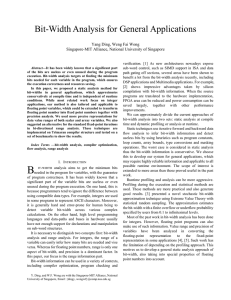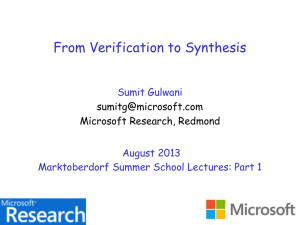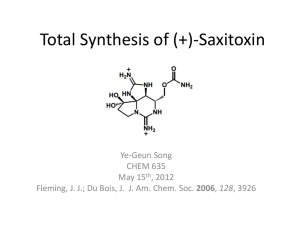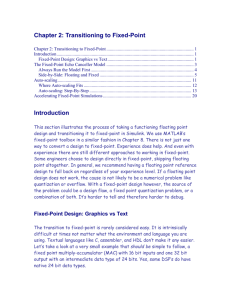An SMT Method for Optimizing Arithmetic Computations, March 14
advertisement
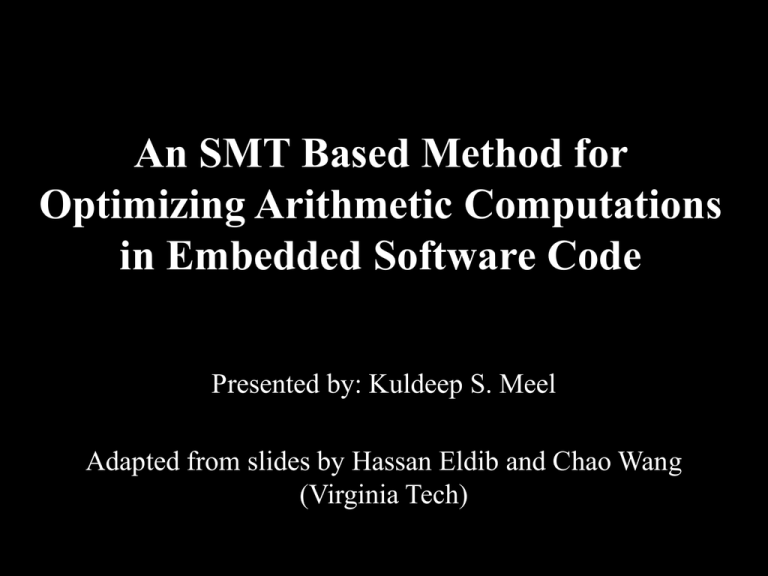
An SMT Based Method for Optimizing Arithmetic Computations in Embedded Software Code Presented by: Kuldeep S. Meel Adapted from slides by Hassan Eldib and Chao Wang (Virginia Tech) A Robotic Dream • Having a tool that automatically synthesizes the optimum version of a software program. 2 Embedded Software 3 Some bugs matter more than others https://www.youtube.com/watch?v=AjUpe7Oh1j0#t=75 4 Some even more …… Cost: US $350 million 5 The Age of Sci-Fi CS • Verification – Verify if there is overflow/underflow bug in the code • Synthesis – Given a reference implementation, synthesize an implementation that does not have any of these bugs 6 Objective • Synthesizing an optimal version of the C code with fixed-point linear arithmetic computation for embedded devices. – Minimizing the bit-width. – Maximizing the dynamic range. 7 Motivating Example • Compute average of A and B on a microcontroller with signed 8-bit fixed-point • Given: A, B ∈ [-20, 80]. • (A +B)/2 may have overflow errors • A/2 + B/2 may have truncation errors • A + (B-A)/2 has neither overflow nor truncation errors . 8 Bit-width versus Range • Larger range requires a larger bit-width. • Decreasing the bit-width, will reduce the range. 9 Fixed-point Representation Representations for 8-bit fixed-point numbers • Range: -128 ↔ 127 • Resolution = 1 • Range : -16 ↔ 15.875 • Resolution = 1/8 Range ∝ Bit-width Resolution ∝ Bit-width 10 Problem Statement Program: Optimized program: Range & resolution of the input variables: A -1000 3000 res. 1/4 B -1000 3000 res. 1/4 … 11 Problem Statement • Given – The C code with fixed-point linear arithmetic computation • Fixed-point type: (s,N,m) – The range and resolution of all input variables • Synthesize the optimized C code with – Reduced bit-width with same input range, or – Larger input range with the same bit-width 12 Restrictions • Bounded loops (via unrolling) • Same bit-width for all the variables and constants – Can have different bit representations 13 SMT-based Inductive Program Synthesis 14 SMT-based Inductive Program Synthesis 15 Step 1: Finding a Candidate Program • Create the most general AST that can represent any arithmetic equation, with reduced bit-width. • Use SMT solver to find a solution such that – For some test inputs (samples), – output of the AST is the same as the desired computation 16 SMT-based Solution Fig. General Equation AST. • SMT encoding for the general equation AST structure – Each Op node can any operation from *, +, -, >> or <<. – Each L node can be an input variable or a constant value. • SMT Solver finds a solution by equating the AST output to that of the desired program 17 SMT Encoding • Ψ = Φ𝑝𝑟𝑜𝑔 ⋀ Φ𝐴𝑆𝑇 ⋀ Φ𝑠𝑎𝑚𝑒𝐼 ⋀ Φ𝑠𝑎𝑚𝑒𝑂 ⋀Φ𝑖𝑛 ⋀ Φ𝑏𝑙𝑜𝑐𝑘 – Φ𝑝𝑟𝑜𝑔 : Desired input program to be optimized. – – – – – Φ𝐴𝑆𝑇 : General AST with reduced bit-width. Φ𝑠𝑎𝑚𝑒𝐼 : Same input values. Φ𝑠𝑎𝑚𝑒𝑂 Same output value. Φ𝑖𝑛 : Test cases (inputs). Φ𝑏𝑙𝑜𝑐𝑘 : Blocked solutions. 18 SMT-based Solution (an example) 𝐴 2 + 𝐵 2 ≡ 19 SMT-based Inductive Program Synthesis 20 Step 2: Verifying the Solution • Is the program good for all possible inputs? – Yes, we found an optimized program – No, block this (bad) solution, and try again 21 SMT Encoding • Φ = Φ𝑝𝑟𝑜𝑔 ⋀ Φ𝑠𝑜𝑙 ⋀ Φ𝑠𝑎𝑚𝑒𝐼 ⋀ Φ𝑑𝑖𝑓𝑓𝑂 ⋀Φ𝑟𝑎𝑛𝑔𝑒𝑠 ⋀ Φ𝑟𝑒𝑠 – Φ𝑝𝑟𝑜𝑔 : Desired input program to be optimized. – 𝚽𝒔𝒐𝒍 : Found candidate solution. – Φ𝑠𝑎𝑚𝑒𝐼 : Same input values. – 𝚽𝒅𝒊𝒇𝒇𝐎 : Different output value. – Φ𝑟𝑎𝑛𝑔𝑒𝑠 : Ranges of the input variables. – Φ𝑟𝑒𝑠 : Resolution of the input variables. 22 SMT-based Inductive Program Synthesis 23 The Next Solution B + 𝐴−𝐵 2 ≡ 24 SMT-based Inductive Program Synthesis 25 Scalability Problem • Advantage of the SMT-based approach – Find optimal solution within an AST depth bound • Disadvantage – Cannot scale up to larger programs • Sketch tool by Solar-Lezama & Bodik (5 nodes) • Our own tool based on YICES (9 nodes) 26 Our Incremental Approach 27 Incremental Optimization • Combine static analysis and SMT-based inductive synthesis. • Apply SMT solver only to small code regions – – – – – Identify an instruction that causes overflow/underflow. Extract a small code region for optimization. Compute redundant LSBs (allowable truncation error). Optimize the code region. Iterate until no more further optimization is possible. 28 Region for Optimization • BFS order (Tree has return as root) – Parent node doesn’t have overflow or underflow – Parent node restores the value created in the overflowing node back to the normal range in orig. – Larger extracted region allows for more opportunities – AST with at most 5 levels, 63 AST nodes 29 Region for optimization Detecting Overflow Errors The parent nodes Some sibling nodes Some child nodes • The addition of a and b may overflow 30 Truncation Error margins Computing Redundant LSBs • The redundant LSBs of a are computed as 4 bits • The redundant LSBs of b are computed as 3 bits. 31 Truncation Error margins • step(x*y) = step(x) + step(y) • step(x+y) = min(step(x),step(y)) • step(x-y) = min(step(x),step(y)) • step(x << c) = step(x) + c • step(x >> c) = max(step(x)-c,0) 32 Extracting Code Region • Extract the code surrounding the overflow operation. • The new code requires a smaller bit-width. 33 Inductive Generation of New Regions – – – – – – : Extracted region of bit width (bw1). : Desired solution with bit wi. : Same input values. : Same output value. : random tests. : Blocked programs 34 Verification • Φ = Φ𝑝𝑟𝑜𝑔 ⋀ Φ𝑠𝑜𝑙 ⋀ Φ𝑠𝑎𝑚𝑒𝐼 ⋀ Φ𝑑𝑖𝑓𝑓𝑂 ⋀Φ𝑟𝑎𝑛𝑔𝑒𝑠 ⋀ Φ𝑟𝑒𝑠 – Φ𝑝𝑟𝑜𝑔 : Desired input program to be optimized. – 𝚽𝒔𝒐𝒍 : Found candidate solution. – Φ𝑠𝑎𝑚𝑒𝐼 : Same input values. – 𝚽𝒅𝒊𝒇𝒇𝐎 : Different output value. – Φ𝑟𝑎𝑛𝑔𝑒𝑠 : Ranges of the input variables. – Φ𝑟𝑒𝑠 : Resolution of the input variables. 35 The Incremental Approach 36 Implementation • Clang/LLVM + Yices SMT solver • Bit-vector arithmetic theory • Evaluated on a set of public benchmarks for embedded control and DSP applications 37 Benchmarks (embedded control software) Benchmark Bits LoC Arithmetic Operations Sobel Image filter Bicycle controller 32 32 42 37 28 27 Locomotive controller IDCT (N=8) 64 32 42 131 38 114 Controller impl. Differ. image filter FFT (N=8) IFFT (N=8) 32 32 32 32 21 131 112 112 8 77 82 90 Citation Qureshi, 2005 Rupak, Saha & Zamani, 2012 Martinez, Majumdar, Saha & Tabuada, 2010 Kim, Kum, & Sung, 1998 Martinez, Majumdar, Saha & Tabuada, 2010 Burger, & Burge, 2008 Xiong, Johnson, & Padua,2001 Xiong, Johnson, & Padua,2001 All benchmark examples are public-domain examples 38 Experiment (increase in range) Input/output range increase 10000 1000 100 Range increase 10 1 Sobel Image Bicycle Locomotive IDCT Controller Diff. Image FFT IFFT • Average increase in range is 307% (602%, 194%, 5%, 40%, 32%, 1515%, 0% , 103%) 39 Experiment (decrease in bit-width) • Required bit-width: 32-bit 16-bit 64-bit 32-bit 40 Experiment (scaling error) Original program New program If we reduce microcontroller’s bit-width, how much error will be introduced? 41 Experiment (runtime statistics) Benchmark Sobel image filter Bicycle controller Locomotive controller IDCT (N=8) Controller impl. Differ. image filter FFT (N=8) IFFT (N=8) Optimized Code Regions Time 22 2 1 3 1 23 14 1 2s 5s 5m 41s 2.7s 46s 10s 1m 9s 4s 64 bit 42 Related Work: Sketch • CEGIS based • Synthesis is over the whole program • Solver not capable of efficiently handling linear fixed-point arithmetic computations (?) 43 Related Work: Gulwani et al. (PLDI 2011) • User specified logical specification (e.g., unoptimized program) • Uses CEGIS to find optimized version • Slow (This technique performs worse than enumeration/stochastic techniques) 44 Related Work: Rupak et al. (ICES 12) • Optimization of bit-vector representations • Does not change structure of the program • Uses Mixed Integer Linear Programming (MILP) Solver 45 Conclusions • We presented a new SMT-based method for optimizing fixed-point linear arithmetic computations in embedded software code – Effective in reducing the required bit-width – Scalable for practice use • Future work – Other aspects of the performance optimization, such as execution time, power consumption, etc. 46 More on Related Work • Solar-Lezama et al. Programming by sketching for bit-streaming programs, ACM SIGPLAN’05. – General program synthesis. Does not scale beyond 3-4 LoC for our application. • Gulwani et al. Synthesis of loop-free programs, ACM SIGPLAN’11. – Synthesizing bit-vector programs. Largest synthesized program has 16 LoC, taking >45mins. Do not have incremental optimization. • Jha. Towards automated system synthesis using sciduction, Ph.D. dissertation, UC Berkeley, 2011. – Computing the minimal required bit-width for fixed-point representation. Do not change the code structure. • Rupak et al. Synthesis of minimal-error control software, EMSOFT’12. – Synthesizing fixed-point computation from floating-point computation. Again, only compute minimal required bit-widths, without changing code structure. 48


